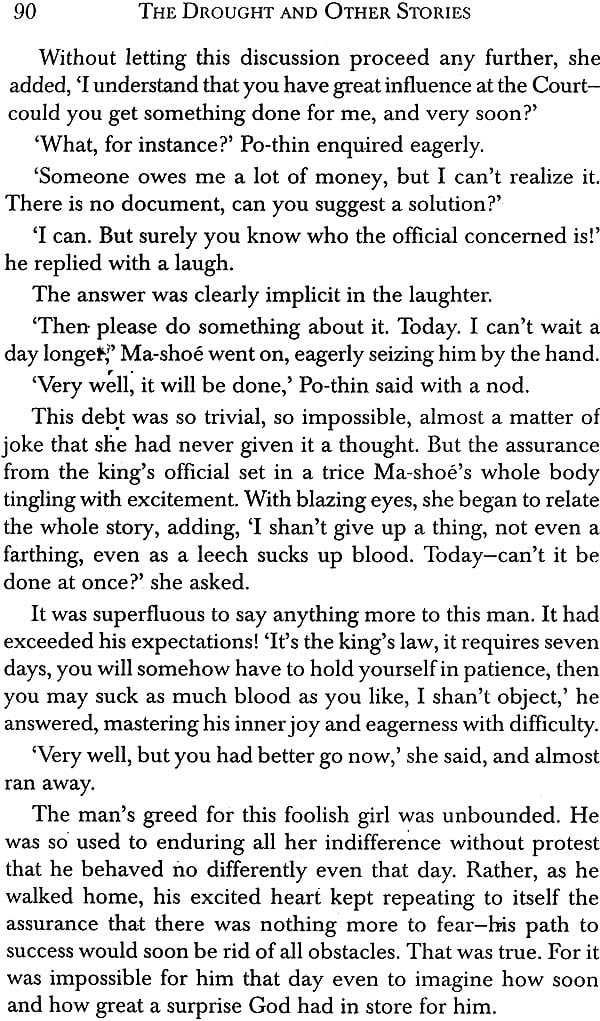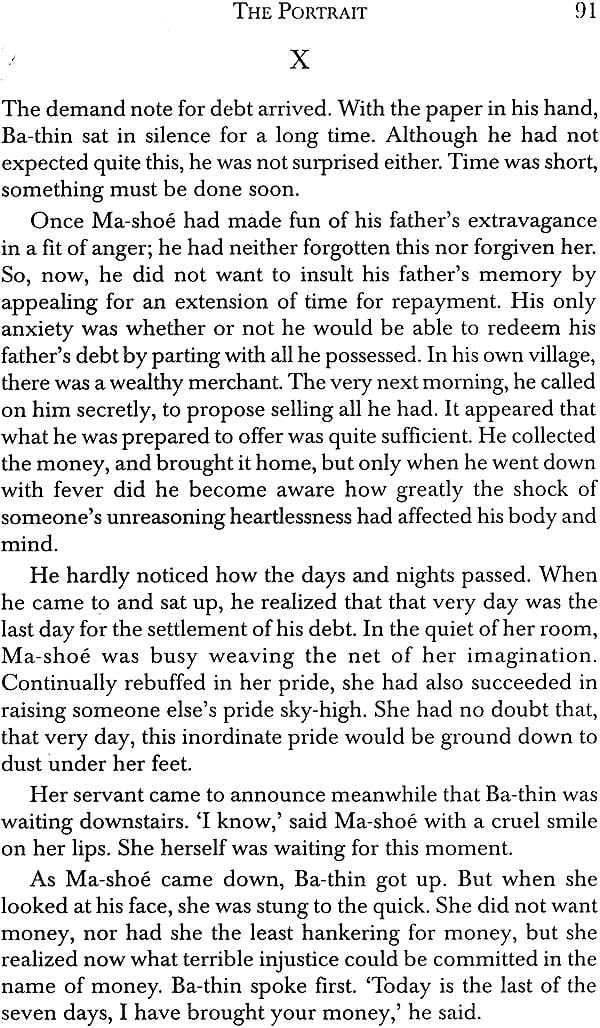
The Drought and Other Stories
Book Specification
| Item Code: | NAK005 |
| Author: | Sarat Chandra Chatterjee |
| Publisher: | SAHITYA AKADEMI, DELHI |
| Language: | English |
| Edition: | 2014 |
| ISBN: | 9788126019311 |
| Pages: | 122 |
| Cover: | Paperback |
| Other Details | 9.0 inch x 6.0 inch |
| Weight | 180 gm |
Book Description
The Drought and Other Stories is a collection of six well known stories by Sarat Chandra Chatterjee, one of the finest Bengali novelists, clearly in the direct line of literary succession to Bankim Chadra Chatterjee and Rabindranath Tagore.
The stories in this collection are guided by tow considerations – their representative character and their variety. They also reflect the mind and art of Sarat Chandra.
The first story "The Drought" is considered one of Sarat Chandra's best short stories. It focuses attention on all the social tensions that have bedevilled the Indian scene and still remains unsolved. The "Snake Charmer's Daughter" is a poignant story of love which binds men and women, irrespective of artificial social difference. "Abhagar Swargar" bring to light the significant sociological fact that the ethos of light the significant sociological fact that the ethos of caste can affect, indeed infect the psychology of even those who are its principal victims. "Ramer Sumathi" is a story of domestic life and is perhaps the only one which can be called a novella. "The Portrait", a romantic tale, is laid in the Buddhist background of Burma, where Sarat Chandra had spent his early youth as a postal clerk.
Sasadhar Sinha, the translator has done an excellent job of translating these stories while still retaining the flavour of the original.
Dr Subodh Chandra Sen Gupta, eminent scholar and literary critic, has written in both Bengali and English on Sarat Chandra Chatterjee [September 12876- January 1938]: man and artist. It would therefore be an act of supererogation on my part, as translator, to wish to write anything ambitious or original on the great writer, whose short stories are the subject of the present volume. Nonetheless, I presume, I owe a few words at least to those of my readers who may have scant or only indirect knowledge of the Bengali language or that of bengal's modern literature. Hence this Preface.
The history of modern Bengali is scarcely a hundred and fifty years old. And it is a product of the long and devoted service rendered to it by many Bengalis, great and small, who, by sustained effort, have succeeded in transforming it into a sensitive and powerful instrument of creative thought and writing. 'It is significant,' writes Aurobindo Ghosh [1872-1950] in The Ideal of Human Unity, 'that the one sub-nation in India which from the first refused to undergo this yoke (that of the English language, that is), devoted itself to the development of its language, made that for ling its principal preoccupation, gave to it its most original minds and most and living energies, getting through everything else perfunctorily...That it is Bengal which gave it the first modern Indian poet of world-wide fame and achievement....
Sarat Chandra was clearly in the direct line of literary succession to both Bankim Chandra Chatterjee [1838-94], the first great Bengali novelist, and Rabindranath Tagore [1861-1941], the first great poet of modern India and the real architect of modern Bengali, both as language and literature, in all its plastic beauty and variety, as in fact all modern Bengali writers are. But being closer in time, as well as in basic outlook, the youngest of the trio was unquestionably in greater debt-as sarat Chandra himself has acknowledged many times-to Tagore than to the elder Chatterjee with whose social conservatism he had little sympathy. Indeed, one would be perfectly entitled to claim that it is doubtful whether without the poet's splendid example to look up to or follow, Sarat Chandra, genius though he was, would or could have become the accomplished writer-an important fact to remember in Bengal's literary history.
The other fact to beat in mind is that, although all the three writers were Brahmin by birth, and occupied the same high social status in the Hindu hierarchy of Bengal, Sarat Chandra had neither the education nor the wealth of either, nor-what is perhaps more important-the wide liberal culture of the Indian poet.
Sarat Chandra was born in dire poverty, and right up to middle age had to fight an uphill fight against it and the neglect and injustices that normally accompany it. He had seen life in the raw, and his novels and short stories are consequently no mere bookish reminiscence, but born out of what he had seen and experienced in his own life. In this sense, he was although it might be well to emphasize that his writings are not all gloom and despondency, they also have their sunny sides of gentle humour and irony as of the poignancy of love and the tenderness of affection which give zest to life-the endearing qualities which undoubtedly account, to some extent at any rate, for the high place he holds, and may be expected to hold in popular affection.
By common consent, Sarat Chandra was an outstanding novelist, perhaps the greatest novelist the Bengal has produced, and he wrote with a directness of experience and style which contrasts refreshingly with the writings of his literary forbears.
As is generally known, he was a product of the Hindu joint gamily. Its importance as a social institution is of particular relevance to Bengal, and only to a lesser degree perhaps to the rest of India, for obvious historical reasons. A knowledge of this institution is therefore a prerequisite for an adequate understanding and appreciation of many of his novels and short stories. The joint family in its heyday, it will be recalled, was primarily a system of social security and an admirable school of training in joint, harmonious living by parents, sons and grandchildren, and often other relations, with all that this involved.
Ideally, of course, the institution could function smoothly only as long as the rural structure of India, the backbone of the Indian economy, remained undisturbed, and economic pressure had not yet become the intolerable burden that it became in due course for the head of the joint family.
Out author obviously wrote in a transitional period when, through the interplay of economic forces, the joint family was already in an advanced state of decay, and was progressively becoming an anachronism, and not unlike the cast system, having outlived its social purpose, was destined to give way to a competitive, individualistic pattern of social organization. In other words, the concept of the joint family, in its classic form, with its corporate, cooperative ethos, its social discipline and ambience of mutual affection among its members, was fast becoming untenable, and instead we therefore come face to nalities and temperaments, and more especially of economic interests. In Sarat Chandra's writing, we thus of the vividness of truth, and of the nostalgia for the lost virtues of the old joint family.
| Preface | vii |
| The Drought [Mahesh] | 1 |
| The snake-charmer's Daughter [Bilashi] | 10 |
| A Gleam of Light [Andhare Alo] | 16 |
| Ramlal's Conversion [Ramer Sumati] | 35 |
| The Portait [Chhabi] | 76 |
| Abhagi's Heaven! [Abhagir Swarga] | 94 |











